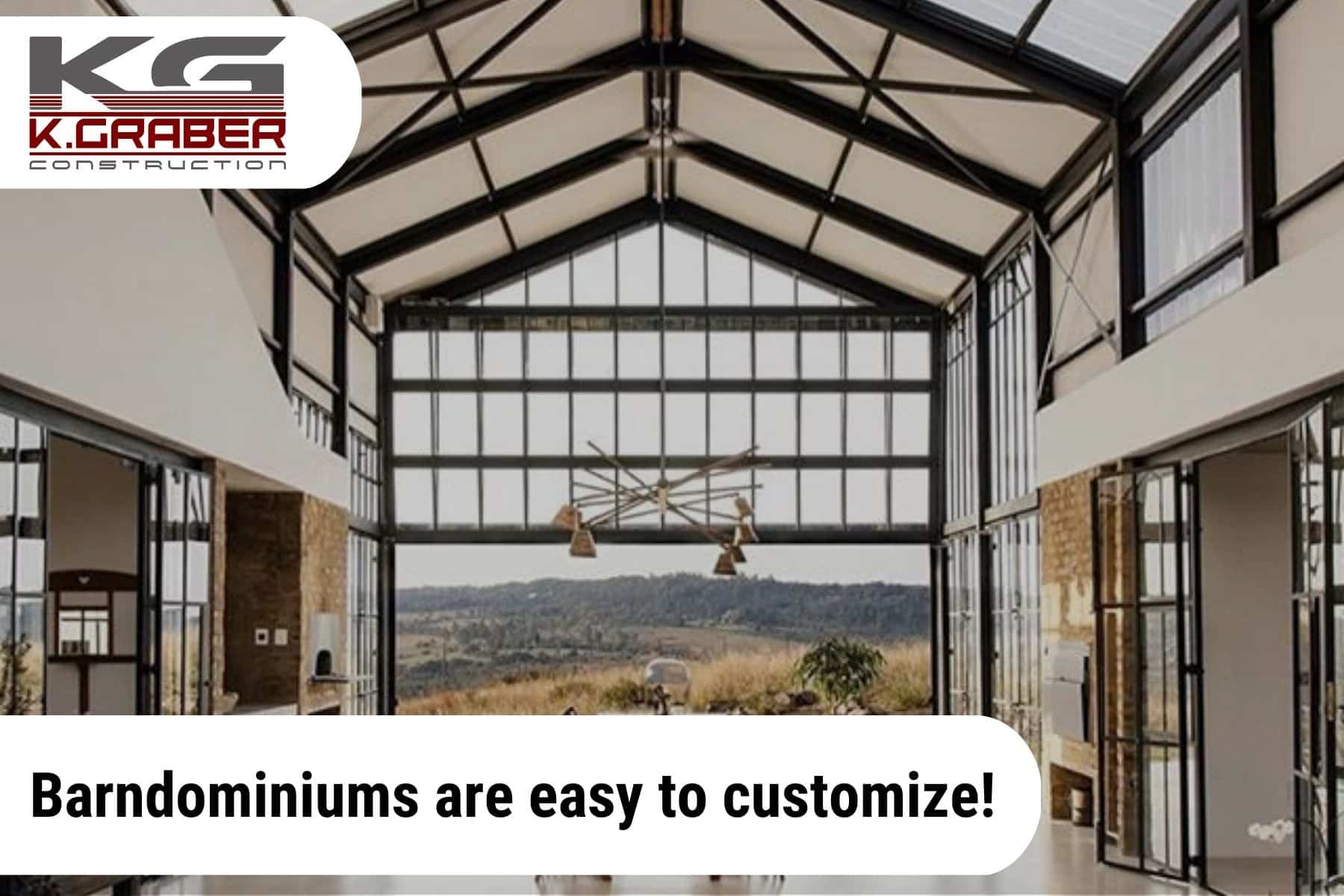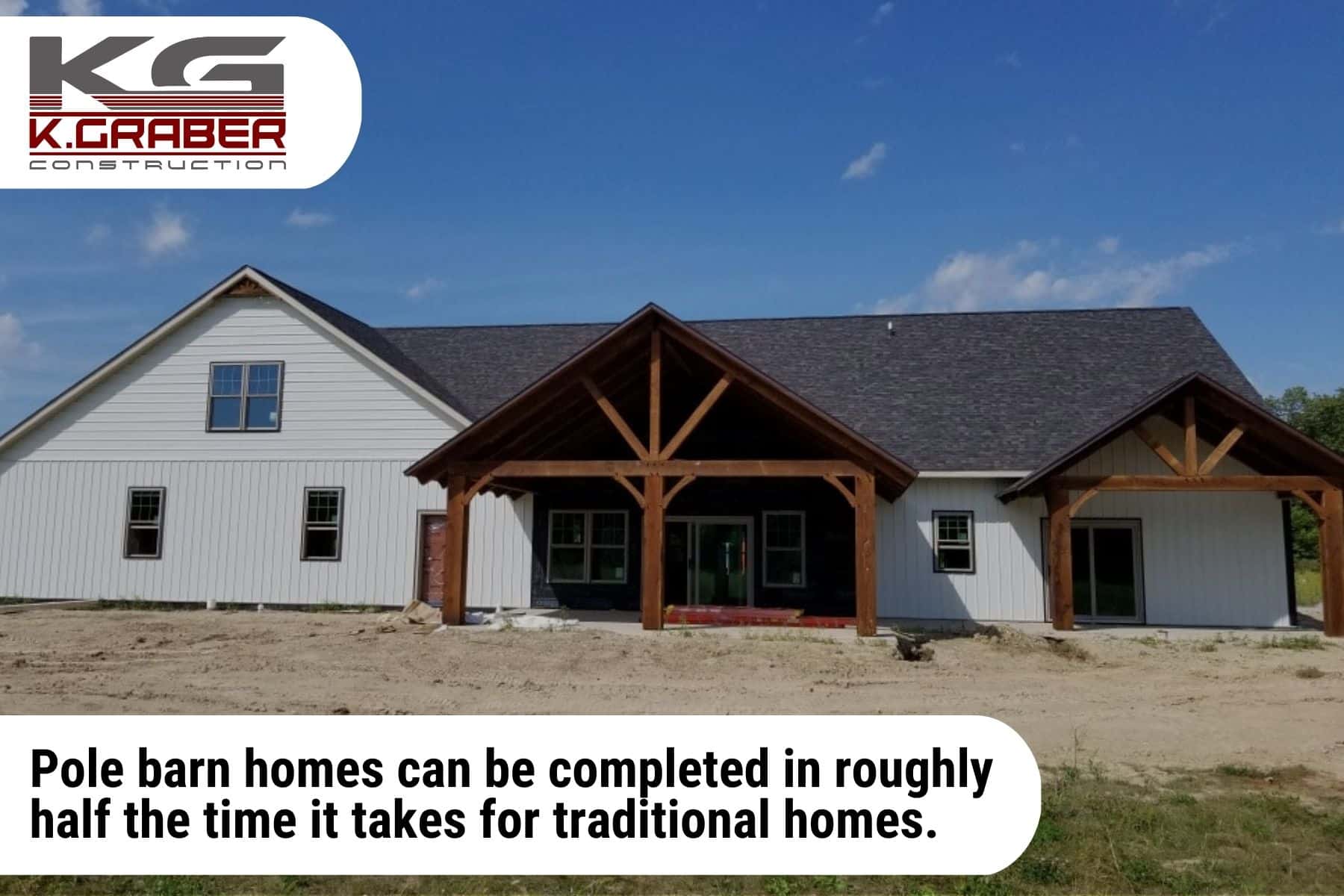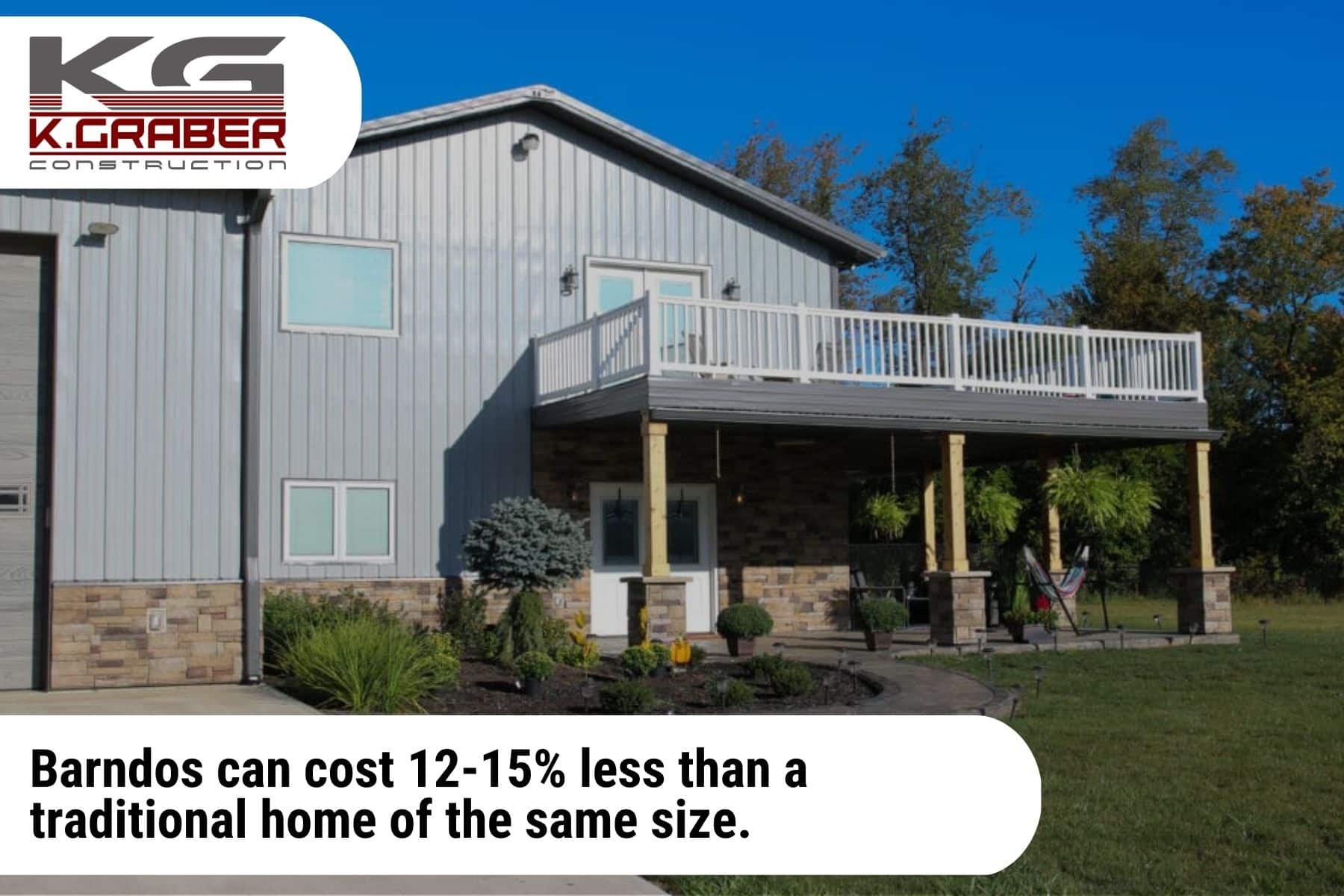
Is A Barndominium For You? 8 Common Barndo Questions Answered
Imagine a budget home with the charm and character of an old barn and extra space included for your favorite hobbies and pastimes.
That would be a “barndominium!”
One of the latest trends in home building, barndos (barn+condominium) combine practicality, affordability, and efficiency with a dash of charm thrown in.
This article by K-Graber Construction helps you learn what barndos are, their pros and cons, and then covers all the most commonly asked questions about them.
Let’s get started!
Table Of Contents
What Is A Barndominium?
A barndominium, also known as a pole barn home, is a living space made from (or combined with) a larger, open area such as a barn, workshop, or shed.
Years ago, farmers combined their living spaces with their barns or shops by building them above or adjoining the larger spaces. It was an efficient, economical place to put your home, as you didn’t have to construct another building, and it would be near your workplace.
In other words:
The idea of combining home and workspace is not new, but it has become more trendy in recent years.
The original idea was to combine your barn and home and live right with your animals. But if living next to horses and cows doesn’t appeal to you, don’t worry. Most modern-day barndo owners don’t use their homes as agricultural structures—most simply like the idea and aesthetic. There are also practical reasons to build this type of home, which we’ll cover later in this article.
Barndominiums typically have spacious, open setups, and their design is a blank canvas for creative homeowners. You can customize them any way you like, and the options are limitless!
If you want to see a few examples of modern-day pole barn homes, check out some of these barndo ideas on Pinterest.
Barndominum Pros and Cons
There’s no question that this home style is romantic and charming. But are there practical reasons to choose a barndo?
You bet there are! Next, we’ll go over the pros and cons of building a barndo so you can assess whether it would be a good choice for you.
Pros
1. Easy customization
These homes are fertile ground for the creative homeowner’s imagination! You can customize the inside however you want, as well as choose from many siding and roofing options.

2. Dual-purpose options
This design is perfect if you want your home to include a workshop, office, store, hobby accommodations, or other space.
3. Cheaper than regular construction
Pole barn homes are normally cheaper to construct than a typical home, mainly because they do not require as much of a foundation.
4. Shorter construction timeline
As well as being cheaper, pole barn homes go up much faster than traditional construction homes. That is because they are typically a post-frame structure, similar to a pole barn.
5. Energy-efficient and eco-friendly
Steel buildings like these tend to lower homeowners' energy bills and are an earth-friendly option.
6. Durable
Pole barn homes are durable and require less maintenance than regular homes. When well-constructed, these buildings last a lifetime!
Cons
1. Loud
Pole barn homes aren’t normally as beefy as standard homes and are often made of metal. That means there’s not much between you and rain on the roof and other outside noises. There are ways to make a barndo quieter, but it's good to go have realistic expectations and understand that you will almost inevitably hear more of the outside world than in a traditional home.
2. Can Look like a barn
If you build a barndo, it’s going to look at least something like a barn. To some, that’s romantic, but it’s not for everyone.

3. Not allowed in certain areas
This type of home is typically found in rural areas where there aren’t many building codes and may not be up to all town and city codes.
4. Require a sprinkler system
It may vary according to different codes, but most pole barn homes require a sprinkler system for fire protection.
5. May be hard to sell
These homes are highly customized, which is a large part of their charm. However, that also means they won’t appeal to everyone, so selling your home could be challenging.
8 Barndominium FAQs
You may still have some questions. After all, building a home is a significant project, and you want to make an informed decision before getting started.
Here are eight of the most commonly asked questions about this type of home:
How long do barndos last?
How long a barndo lasts depends on its environment, quality of construction, materials, and quality of maintenance. Any slapped-together structure will not stand the test of time.
But a well-constructed barndo lasts for years, just like a traditional home, although you may need to replace doors, gutters, windows, or other elements. A well-built structure could stand firm for hundreds of years.
Are barndos hard to insure?
If you build this type of home, you should know that insuring your barndo may not be exactly like insuring a house. Not all insurance companies cover barndominiums, and some don’t cover buildings with metal siding. Others may not cover dual-purpose structures, a category most of these homes fall into.
However, depending on your situation, you can get barndominium insurance just as easily as regular home insurance.
If your home includes a workspace, the function of the workspace plays into how high your premiums are. For example, if you use potentially hazardous equipment in your workspace, your rates will be more expensive.
How long does it take to build a pole barn home?
How long it takes to build a pole barn home depends on various factors, such as size, whether you are going to DIY or hire a contractor, and how much customization you want.
A simple barndo could take 3-6 months, whereas a large custom one may take over a year. According to this article with Stacee Lynn, the Barndominium Lady, most can be completed in roughly half the time it takes to construct a regular home.

Do barndos hold their value?
Barndominiums normally retain their resale value and may even increase in value gradually, although more slowly than a standard home.
However, these homes are still rare in some parts of the country, and it may be challenging to get an accurate appraisal in an area where there are few.
Are barndos energy efficient?
Steel buildings such as these are typically sided with metal and insulated with spray foam insulation. A properly insulated metal building is highly energy efficient and doesn’t put a lot of stress on your heating and cooling system.
If you add other energy-efficient features such as awnings, high-performance doors, windows, and LED lighting, you can reduce your energy bills by 40%, according to westernstatesmetalroofing.com.
Is it cheaper to build a barndominium or a house?
The cost of a pole barn home depends on the size, materials, and method of building, but they are generally cheaper to build than a house.
One factor that plays in is that pole barn structures are easy to build, so some homeowners choose to DIY them. This saves you the money it would take to hire a contractor and allows you to shop around for second-hand appliances and fixtures.
Stacee Lynn, the Barndominium Lady, says, “Overall, I would say if you are acting as general contractor and you are a good shopper…I would say you would save around 12-15%...if you are hiring a general contractor, now you are really close to what it’s going to cost to build a traditional home.”
If you want more info from Stacee Lynn, here is an extremely helpful interview with the Barndominium Lady going over the pros, cons, and building process.

How are barndos so cheap?
These homes can save you money in several ways:
- They are quick to build, and time is money. The quicker your construction timeline, the more money you save.
- Their shells require fewer materials and layers. For example, a typical home exterior could consist of brick, a vapor barrier, plywood, a wood frame, insulation, and sheetrock. A typical barndo might consist of sheet metal, plywood, a metal frame, spray foam insulation, and sheetrock.
- They lower your energy bills.
- They don’t require a foundation like a normal house. This saves you time, materials, and labor.
- It’s possible to assemble your own barndo kit, saving you the money it would take to hire a contractor.
- Not hiring a contractor means you can shop around for secondhand fixtures and appliances.
Are barndos safe?
If you are worried about a pole barn home not being safe, you can put your worries to rest.
Barndos are just as safe as traditional homes and, in some ways, safer. Steel ones are tougher and safer than wood-framed ones, but both are completely safe to live in.
Steel ones are fire resistant and can stand up to wind, tornadoes, hurricanes, and earthquakes just as well, if not better than traditional homes. Also, steel has a lower electrical resistance than many materials, making it safer in lightning strikes.
These homes also tend to require less maintenance, being made almost entirely of steel.
Conclusion
Now you know a bit more about what a barndo is and whether it’s a good choice for you!
If you are looking for a contractor to build you a beautiful pole barn home, contact us here at K Graber Construction! We build pole barn homes in North Central Indiana.
We also offer other services, including:
- Metal roofing
- Concrete contracting
- ICF construction
- Steel building construction
- New home construction
And more! Contact us today to start the conversation about your barndominium!
We look forward to hearing from you.



